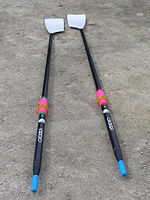- Oar (sport rowing)
-
In rowing, oars are used to propel the boat. Oars differ from paddles in that they use a fixed fulcrum to transfer power from the handle to the blade, rather than using the athlete's shoulders or hands as the pivot-point as in canoeing and kayaking. Typical Sculling oars are around 284 cm - 290 cm in length, and rowing oars 370 cm - 376 cm long. The shaft of the oar ends with one flat end about 50 cm long and 25 cm wide, called the blade. The part of the oar the oarsman holds while rowing is called the handle. While rowing, the oars are supported by metal frames attached to the side of the boat called riggers.
The parts of an oar are (labelled from outside the boat first): spoon, loom (or shaft), 2/3 of the way up is the sleeve(including a wearplate) and button (or collar), and at the very end the handle and grip.
An oar is often referred to as a "blade" in the case of sweep oar rowing and as a "scull" in the case of sculling. A sculling oar is shorter and has a smaller blade area than the equivalent sweep oar.
There are hundreds of different variations of oars, but "Macon" or "Cleaver" blades of carbon-fiber are the most common in modern sport rowing. Classic oars were made out of wood, but since the use of synthetic materials, the weight of an oar has come down from over 7 kg, to less than 2.5 kg.[citation needed]
Blade shapes
Modern blades come in two main shapes. The most common is the "cleaver" (also called "hatchet"), which is used almost universally. Some clubs use the older "macon" style blades (also called "spoons" or "tulips" or "shovels") for novice crews. A very small minority of coaches favor macons for their top crews, but it has been generally accepted since their introduction in 1992 that cleavers give a speed advantage over macons under most conditions.[citation needed]
Macon blades are symmetrical, with an elliptical shape and a ridgeline running down the center of the blade face. The blade is squared off at the end. Despite the blade being symmetrical, modern asymmetrical collars or aesthetic issues regarding decorative paint on the blade face may dictate which side of the boat the blade can be rowed on. Macon blades achieved prominence at the 1959 European Championship in Mâcon.
Cleaver blades are asymmetrical, with a somewhat rectangular shape resembling a meat cleaver, hence the name. The shaft of a cleaver blade connects to the spoon offset to the top edge of the blade. The shape of the face and the offset connection is designed to maximize the surface area of the blade in contact with the water during the rowing stroke, while also minimizing the amount and depth of the shaft that is submerged and contributing to drag. A cleaver blade may only be rowed on one side of the boat or the other. Cleaver blade designs were first developed by Dick and Pete Dreissigacker in 1991 [1].
Prior to the development of the macon blade a longer, thinner shape was used, known as "square" blades or "standard" blades. They are still occasionally used in training for technique.[citation needed] The development from standard to hatchet, via the macon, is therefore a progression from long, thin blades to shorter, wider ones. In each case there has been a reduction in the area of the blade that actually moves the wrong way through the water: in practice a point of the blade remains stationary relative to the water, with the portion outboard of that point providing drive, and the area inboard of it providing drag. Shorter, wider blades place this pivot point closer to the blade's neck, reducing the area dragging in the water.[citation needed]
See also
References
Categories:
Wikimedia Foundation. 2010.


